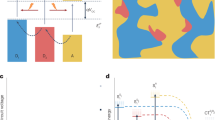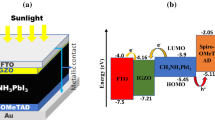Abstract
Organic solar cells are a rapidly expanding subfield of photovoltaics. The publication presents simulation results for organic cells with a focus on optimizing cells and maximizing performance using OghmaNano software. The efficiencies obtained from the simulation of the ternary solar devices were received. The efficiency achieved from simulations for the mobility of charge carriers as well as the dependence of the performance on the effective density from free electron and hole states were simulated. The most favorable ratios of hole and electron mobility and charge carrier densities were determined in terms of device efficiency. The impact of loss processes on the cell efficiency was also investigated.
Graphical Abstract









Similar content being viewed by others
References
Joseph, J.D., Jasmin, M., Sidharth, S.R.: Fabrication and characterization of silicon solar cells towards improvement of power efficiency. Mater. Today Proc. 62, 2050–2055 (2022). https://doi.org/10.1016/J.MATPR.2022.02.493
Chatterjee, A., Ravindra, A.V., Kiran Kumar, G., Rajesh, C.: Improvement in the light conversion efficiency of silicon solar cell by spin coating of CuO, ZnO nanoparticles and CuO/ZnO mixed metal nanocomposite material. J. Indian Chem. Soc. 99, 100653 (2022). https://doi.org/10.1016/J.JICS.2022.100653
Akshay, V.V., Benny, S., Bhat, S.V.: Solution-processed antimony chalcogenides based thin film solar cells: a brief overview of recent developments. Sol. Energy 241, 728–737 (2022). https://doi.org/10.1016/J.SOLENER.2022.06.042
Vijayan, K., Vijayachamundeeswari, S.P., Sivaperuman, K., Ahsan, N., Logu, T., Okada, Y.: A review on advancements, challenges, and prospective of copper and non-copper based thin-film solar cells using facile spray pyrolysis technique. Sol. Energy 234, 81–102 (2022). https://doi.org/10.1016/J.SOLENER.2022.01.070
Wang, L., Hu, M., Zhang, Y., Yuan, Z., Hu, Y., Zhao, X., Chen, Y.: High molecular weight polymeric acceptors based on semi-perfluoroalkylated perylene diimides for pseudo-planar heterojunction all-polymer organic solar cells. Polymer (Guildf). 255, 125114 (2022). https://doi.org/10.1016/J.POLYMER.2022.125114
Lee, S., Yang, H.S., Song, S., Lee, W., Lee, W.K., Park, S.H., Kim, J.Y., Jin, Y.: A low bandgap conjugated polymer bearing a phenazine moiety for application in organic solar cells. Synth. Met. 289, 117114 (2022). https://doi.org/10.1016/J.SYNTHMET.2022.117114
Li, J., Zhao, L., Wang, S., Hu, J., Dong, B., Lu, H., Wan, L., Wang, P.: Great improvement of photoelectric property from co-sensitization of TiO2 electrodes with CdS quantum dots and dye N719 in dye-sensitized solar cells. Mater. Res. Bull. 48, 2566–2570 (2013). https://doi.org/10.1016/j.materresbull.2013.03.009
Kumavat, P.P., Sonar, P., Dalal, D.S.: An overview on basics of organic and dye sensitized solar cells, their mechanism and recent improvements. Renew. Sustain. Energy Rev. 78, 1262–1287 (2017). https://doi.org/10.1016/j.rser.2017.05.011
Jafarzadeh, F., Aghili, H., Nikbakht, H., Javadpour, S.: Design and optimization of highly efficient perovskite/homojunction SnS tandem solar cells using SCAPS-1D. Sol. Energy 236, 195–205 (2022). https://doi.org/10.1016/j.solener.2022.01.046
Mir, F.A.: Exploring the structure as well as electrical and photovoltaic mechanism in PrFe0.5Ni0.5O3/GaAs heterojunction. Mater. Sci. Semicond. Process. 29, 206–212 (2015). https://doi.org/10.1016/j.mssp.2014.03.003
Emrul Kayesh, M., Matsuishi, K., Chowdhury, T.H., Kaneko, R., Noda, T., Islam, A.: Enhanced photovoltaic performance of perovskite solar cells by copper chloride (CuCl2) as an additive in single solvent perovskite precursor. Electron. Mater. Lett. 14, 712–717 (2018). https://doi.org/10.1007/S13391-018-0075-5/TABLES/1
Zheng, Z., Yao, H., Ye, L., Xu, Y., Zhang, S., Hou, J.: PBDB-T and its derivatives: a family of polymer donors enables over 17% efficiency in organic photovoltaics. Mater. Today (2019). https://doi.org/10.1016/j.mattod.2019.10.023
Shi, M., Sun, R., Wang, T., Luo, Z., Guo, J., Guo, J., Yang, C., Min, J.: Two similar near-infrared (IR) non-fullerene acceptors as near IR sensitizers for ternary solar cells. Org. Electron. 85, 105880 (2020). https://doi.org/10.1016/j.orgel.2020.105880
Sun, R., Wang, W., Yu, H., Chen, Z., Xia, X.X., Shen, H., Guo, J., Shi, M., Zheng, Y., Wu, Y., Yang, W., Wang, T., Wu, Q., (Michael) Yang, Y., Lu, X., Xia, J., Brabec, C.J., Yan, H., Li, Y., Min, J.: Achieving over 17% efficiency of ternary all-polymer solar cells with two well-compatible polymer acceptors. Joule 5, 1548–1565 (2021). https://doi.org/10.1016/J.JOULE.2021.04.007
Wang, Y., Zhuang, C., Fang, Y., Yu, H., Wang, B.: Various roles of dye molecules in organic ternary blend solar cells. Dye. Pigment. 176, 108231 (2020). https://doi.org/10.1016/j.dyepig.2020.108231
Fan, H., Shang, H., Li, Y., Zhan, X.: Efficiency enhancement in small molecule bulk heterojunction organic solar cells via additive. Appl. Phys. Lett. 97, 133302 (2010). https://doi.org/10.1063/1.3491268
Wan, Z., Jia, C., Wang, Y., Luo, J., Yao, X.: Significant improvement of phenothiazine organic dye-sensitized solar cell performance using dithiafulvenyl unit as additional donor. Org. Electron. 27, 107–113 (2015). https://doi.org/10.1016/J.ORGEL.2015.09.009
Liu, J., Zhao, S., Huang, Y., Xu, Z., Qiao, B., Yang, L., Zhu, Y., Li, Z., Yuan, B., Xu, X.: Improving charge transport and suppressing charge recombination in small molecule ternary solar cells via incorporating Bis-PC71BM as a cascade material. Org. Electron. 46, 126–132 (2017). https://doi.org/10.1016/j.orgel.2017.03.030
Clugston, D.A., Basore, P.A.: PC1D version 5: 32-bit solar cell modeling on personal computers. Undefined (1997). https://doi.org/10.1109/PVSC.1997.654065
Stangl, R., Leendertz, C., Haschke, J.: Numerical simulation of solar cells and solar cell characterization methods: the open-source on demand program AFORS-HET. Sol. Energy (2010). https://doi.org/10.5772/8073
A. Froitzheim, R. Stangl, L. Elstner, M. Kriegel, W. Fuhs, AFORS-HET: A computer-program for the simulation of hetero-junction solar cells to be distributed for public use. In: Proceedings 3rd World Conference Photovoltaic Energy Conversion, 2003. (pp. 279–282).
Bilgic Aksari, M., Eray, A.: Optimization of a Si HcSi heterojunction solar cells by numerical simulation. Energy Procedia. 10, 101–105 (2011). https://doi.org/10.1016/j.egypro.2011.10.160
Burgelman, M., Nollet, P., Degrave, S.: Modelling polycrystalline semiconductor solar cells. Thin Solid Films 361–362, 527–532 (2000). https://doi.org/10.1016/S0040-6090(99)00825-1
Gutiérrez-González, I., Molina-Brito, B., Götz, A.W., Castillo-Alvarado, F.L., Rodríguez, J.I.: Structural and electronic properties of the P3HT-PCBM dimer: a theoretical Study. Chem. Phys. Lett. 612, 234–239 (2014). https://doi.org/10.1016/J.CPLETT.2014.08.030
Dyer-Smith, C., Nelson, J., Li, Y.: Organic Solar Cells. McEvoys Handb. Photovolt. Fundam. Appl. (2018). https://doi.org/10.1016/B978-0-12-809921-6.00015-X
Groves, C., Greenham, N.C.: Bimolecular recombination in polymer electronic devices. Phys. Rev. B 78, 155205 (2008). https://doi.org/10.1103/PHYSREVB.78.155205/FIGURES/4/MEDIUM
MacKenzie, R.C.I., Shuttle, C.G., Chabinyc, M.L., Nelson, J.: Extracting Microscopic device parameters from transient photocurrent measurements of P3HT: PCBM solar cells. Adv. Energy Mater. 2, 662–669 (2012). https://doi.org/10.1002/AENM.201100709
Wasule, S.R., O’carroll D.M., Theory and analysis of the luminance of top-emitting and bottom-emitting OLEDs, (2021). https://doi.org/10.7282/T3-BDP6-BH09.
Kowsar, A., Billah, M., Dey, S., Debnath, S.C., Yeakin, S., Uddinfarhad, S.F.: Comparative Study on Solar Cell Simulators. ICIET 2019–2nd Int Conf. Innov. Eng. Technol. (2019). https://doi.org/10.1109/ICIET48527.2019.9290675
Lewinska, G.: Materials for D-D-A ternary organic solar cells: An absorption model study. Adv. Opt. Technol. 9, 155–160 (2020). https://doi.org/10.1515/aot-2019-0055
Coropceanu, V., Cornil, J., Olivier, Y., Silbey, R., Bredas, J.L., da Silva Filho, D.A.: Charge transport in organic semiconductors. Chem. Rev. 107, 926–952 (2007). https://doi.org/10.1007/128_2011_218
Tiwari, S., Greenham, N.C.: Charge mobility measurement techniques in organic semiconductors. Opt. Quantum Electron. 41, 69–89 (2009). https://doi.org/10.1007/s11082-009-9323-0
Ullah, I., Shah, S.K., Wali, S., Hayat, K., Khattak, S.A., Khan, A.: Enhanced efficiency of organic solar cells by using ZnO as an electron-transport layer. Mater. Res. Express. 4, 125505 (2017). https://doi.org/10.1088/2053-1591/AA9DC9
Larson, B.W., Whitaker, J.B., Bin Wang, X., Popov, A.A., Rumbles, G., Kopidakis, N., Strauss, S.H., Boltalina, O.V.: Electron affinity of Phenyl-C61-butyric acid methyl ester (PCBM). J. Phys. Chem. C 117, 14958–14964 (2013). https://doi.org/10.1021/JP403312G/ASSET/IMAGES/LARGE/JP-2013-03312G_0002.JPEG
Brink, C., Andersen, L.H., Hvelplund, P., Mathur, D., Voldstad, J.D.: Laser photodetachment of C60–and C70–ions cooled in a storage ring. Chem. Phys. Lett. 233, 52–56 (1995). https://doi.org/10.1016/0009-2614(94)01413-P
Oh, I.S., Kim, G.M., Han, S.H., Oh, S.Y.: PEDOT:PSS-free organic photovoltaic cells using tungsten oxides as buffer layer on anodes. Electron. Mater. Lett. 9, 375–379 (2013). https://doi.org/10.1007/S13391-013-0003-7/METRICS
Szlachcic, P., Danel, K.S., Gryl, M., Stadnicka, K., Usatenko, Z., Nosidlak, N., Lewińska, G., Sanetra, J., Kuźnik, W.: Organic light emitting diodes (OLED) based on helical structures containing 7-membered fused rings. Dye. Pigment. 114, 184–195 (2015)
Mannekutla, J.R., Ramamurthy, P., Mulimani, B.G., Inamdar, S.R.: Rotational dynamics of UVITEX-OB in alkanes, alcohols and binary mixtures. Chem. Phys. 340, 149–157 (2007). https://doi.org/10.1016/j.chemphys.2007.08.014
Zhang, R., Zheng, H., Shen, J.: Blue light-emitting diodes based on coronene-doped polymers. Synth. Met. 105, 49–53 (1999)
Lewińska, G., Puszyński, A., Sanetra, J.: BBOT for applications in photovoltaic cells devices and organic diodes. Synth. Met. 199, 335–338 (2015). https://doi.org/10.1016/J.SYNTHMET.2014.11.013
Lewińska, G., Danel, K.S., Sanetra, J.: The bulk heterojunction cells based on new helicenes—preparation, implementation and surface examination. Sol. Energy 135, 848–853 (2016)
Sinaga, J.E.E., Budianto, G., Pritama, V.L.: Suhendra, Indonesian physical review, Indones. Phys. Rev. 6, 114–123 (2023)
Wilken, S., Scheunemann, D., Dahlström, S., Nyman, M., Parisi, J., Österbacka, R.: How to reduce charge recombination in organic solar cells: there are still lessons to learn from P3HT: PCBM. Adv. Electron. Mater. (2021). https://doi.org/10.1002/AELM.202001056
Li, W., Zeiske, S., Sandberg, O.J., Riley, D.B., Meredith, P., Armin, A.: Organic solar cells with near-unity charge generation yield. Energy Environ. Sci. 14, 6484 (2021). https://doi.org/10.1039/d1ee01367j
Yu, R., Wu, G., Tan, Z.: Realization of high performance for PM6:Y6 based organic photovoltaic cells. J. Energy Chem. 61, 29–46 (2021). https://doi.org/10.1016/J.JECHEM.2021.01.027
Guo, Q., Guo, Q., Geng, Y., Tang, A., Zhang, M., Du, M., Sun, X., Zhou, E.: Recent advances in PM6:Y6-based organic solar cells. Mater. Chem. Front. 5, 3257–3280 (2021). https://doi.org/10.1039/D1QM00060H
Zhang, W., Song, W., Huang, J., Huang, L., Yan, T., Ge, J., Peng, R., Ge, Z.: Graphene: silver nanowire composite transparent electrode based flexible organic solar cells with 13.4% efficiency. J. Mater. Chem. A. 7, 22021–22028 (2019). https://doi.org/10.1039/C9TA07493G
Wang, C., Xu, X., Zhang, W., Dkhil, S.B., Meng, X., Liu, X., Margeat, O., Yartsev, A., Ma, W., Ackermann, J., Wang, E., Fahlman, M.: Ternary organic solar cells with enhanced open circuit voltage. Nano Energy 37, 24–31 (2017). https://doi.org/10.1016/j.nanoen.2017.04.060
Han, J., Bao, F., Huang, D., Wang, X., Yang, C., Yang, R., Jian, X., Wang, J., Bao, X., Chu, J.: A universal method to enhance flexibility and stability of organic solar cells by constructing insulating matrices in active layers. Adv. Funct. Mater. 30, 2003654 (2020). https://doi.org/10.1002/ADFM.202003654
Neher, D., Kniepert, J., Elimelech, A., Jan, L., Koster, A.: A new figure of merit for organic solar cells with transport-limited photocurrents OPEN. Nat. Publ. Gr. (2016). https://doi.org/10.1038/srep24861
Zhou, J., He, D., Li, Y., Huang, F., Zhang, J., Zhang, C., Yuan, Y., Lin, Y., Wang, C., Zhao, F.: Reducing trap density in organic solar cells via extending the fused ring donor unit of an A-D–A-type nonfullerene acceptor for over 17% efficiency. Adv. Mater. 35, 2207336 (2023). https://doi.org/10.1002/ADMA.202207336
Leong, W.L., Cowan, S.R., Heeger, A.J.: Differential resistance analysis of charge carrier losses in organic bulk heterojunction solar cells: Observing the transition from bimolecular to trap-assisted recombination and quantifying the order of recombination. Adv. Energy Mater. 1, 517–522 (2011). https://doi.org/10.1002/aenm.201100196
Campoy-Quiles, M., Ferenczi, T., Agostinelli, T., Etchegoin, P.G., Kim, Y., Anthopoulos, T.D., Stavrinou, P.N., Bradley, D.D.C., Nelson, J.: Morphology evolution via self-organization and lateral and vertical diffusion in polymer: fullerene solar cell blends. Nat. Mater. 7, 158–164 (2008)
Yoon, S., Han, Y., Hwang, I.: Probing molecular orientation of P3HT nanofibers in fiber-based organic solar cells. Electron. Mater. Lett. 14, 46–51 (2018). https://doi.org/10.1007/S13391-017-7155-9/METRICS
Acknowledgements
This paper was financially supported by the AGH University of Science and Technology, project no 16.16.230.434.
Author information
Authors and Affiliations
Corresponding author
Ethics declarations
Conflict of interest
The authors declare that they have no known competing interests.
Additional information
Publisher's Note
Springer Nature remains neutral with regard to jurisdictional claims in published maps and institutional affiliations.
Rights and permissions
Springer Nature or its licensor (e.g. a society or other partner) holds exclusive rights to this article under a publishing agreement with the author(s) or other rightsholder(s); author self-archiving of the accepted manuscript version of this article is solely governed by the terms of such publishing agreement and applicable law.
About this article
Cite this article
Lewińska, G. Ternary Organic Solar Cells—Simulation–Optimization Approach. Electron. Mater. Lett. (2024). https://doi.org/10.1007/s13391-023-00479-4
Received:
Accepted:
Published:
DOI: https://doi.org/10.1007/s13391-023-00479-4




